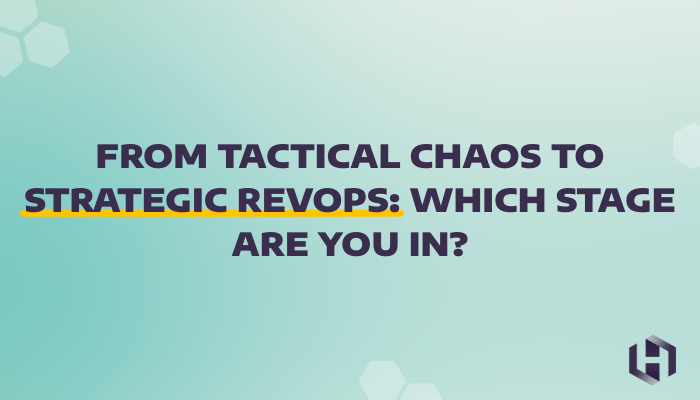You know that moment when everything looks fine on the surface, but underneath, your teams are scrambling? Marketing passes leads to sales with little context. Sales closes a deal, but customer success doesn’t hear about it until the onboarding call. Data lives in six different tools, and no one’s confident in the forecast.
That's RevOps in action.... but at the wrong stage.
RevOps isn’t something you either “have” or “don’t have.” It’s a journey. Some teams are stuck fighting fires in Tactical Chaos, while others operate with the precision of Strategic RevOps. Most fall somewhere in between.
The question is: where do you land? And just as important—how do you move forward? To figure that out, we first need to know the different stages of RevOps Maturity.
The Four Stages of RevOps Maturity
Every organization sits somewhere on the RevOps maturity curve. Some are stuck reacting to problems, while others are scaling with predictable growth. Understanding the four stages of maturity gives you a framework to identify where you are today and what needs to change to get to the next level.
- Tactical Chaos: Silos, reactivity, and inconsistent performance define your day-to-day. You’re running uphill.
- Emerging Ops: You’re making progress, but critical gaps still cost time and revenue.
- Integrated Engine: Your processes and data are structured and scaling, though adoption may still lag.
- Strategic RevOps: Teams, tools, and data operate in sync. Training is embedded, leadership is aligned, and growth feels predictable.
Tactical Chaos: Where Revenue Leaks Begin
When teams operate in silos, opportunities fall through the cracks. Leads get stuck, data is messy, and no one agrees on what “qualified” even means. If the opening scenario feels familiar—the handoffs without context, the late notifications to customer success, the tangled web of tools—you’re in Tactical Chaos. You’re not alone. Most companies start here, but the leaks add up quickly.
That chaos is expensive. 70% of new revenue at leading B2B SaaS companies comes from expanding or renewing existing customer relationships. But when customer success, sales, and marketing aren’t aligned, those opportunities never materialize.
Emerging Ops: Progress Meets Growing Pains
At this stage, you’ve started to put structure in place—maybe there’s an SLA between sales and marketing, or automated handoffs for leads. The problem? Inconsistency. Processes exist, but adoption lags.
This is where the STICKY methodology starts to move the needle:
Spot the Need: Document lifecycle stages, track funnel leakage, and create visibility into where deals die.
Trigger the Next Step: Automate handoffs so nothing sits idle in your pipeline.
When 82% of companies recognize that retaining existing customers is more cost-effective than acquiring new ones, these steps become the difference between growth and churn.
Integrated Engine: The Building Blocks of Scale
You’re past firefighting. Processes are consistent, dashboards give a shared view of the funnel, and your teams are aligning on shared KPIs. This is where RevOps becomes a real growth engine.
But even here, adoption can lag. Tools are often underutilized or scattered across teams. That’s why the next part of the STICKY framework matters:
In-Context Enablement: Don’t bury training in a PDF. Embed resources directly in the tools your teams use every day.
Connect to Resources: Assign tool owners, avoid tech bloat, and make sure everyone is trained on the platforms they rely on.
By 2026, 75% of the highest-growth companies will adopt a RevOps model. Integrated Engines are the ones positioned to ride that wave.
Strategic RevOps: Alignment at Scale
This is where RevOps turns from a back-office function into a competitive advantage. Clean data, aligned leadership, and fully activated teams make revenue predictable.
Two final STICKY principles keep organizations at this level:
Keep It Simple: Eliminate busywork and measure what matters—not just what’s easy to track.
Your Team Activated: Ensure every team member understands the KPIs that drive growth and has the resources to act on them.
Companies that bring sales and marketing together see an increase in revenue of 208%. Strategic RevOps makes that alignment part of your DNA. Now... imagine that same opening scenario—but flipped. Marketing, sales, and customer success now share a single source of truth. Every handoff is automated, every rep has resources right in their tools, and leadership trusts the forecast. That’s what Strategic RevOps feels like.
Where Do You Land?
Most companies sit somewhere between Emerging Ops and Integrated Engine. Progress doesn’t come from reinventing the wheel—it comes from embedding proven practices like STICKY into your day-to-day workflows. To score your organization, find your current stage, and see what it takes to climb to the next–check out our RevOps Maturity Checklist.




.png?width=100&height=100&name=Why%20Were%20Not%20a%20Marketing%20Agency%20(And%20What%20That%20Means%20for%20Your%20Growth).png)
